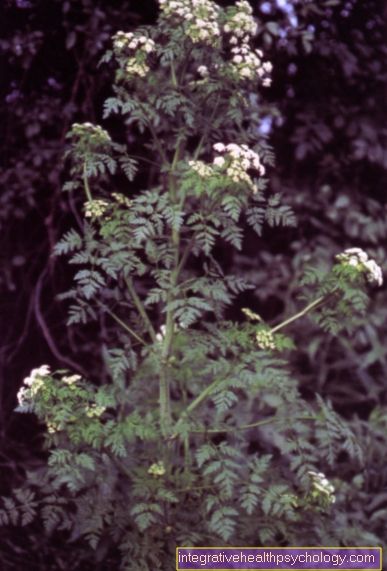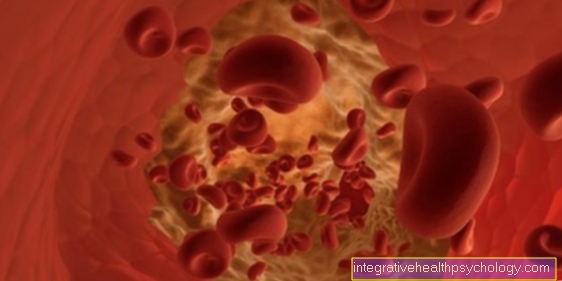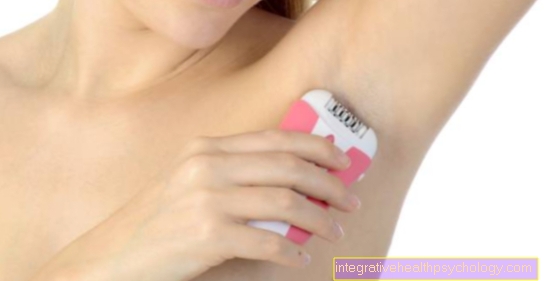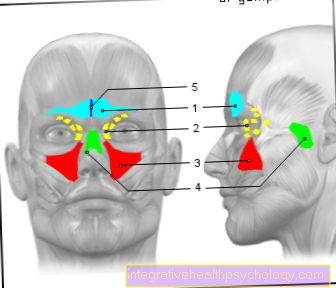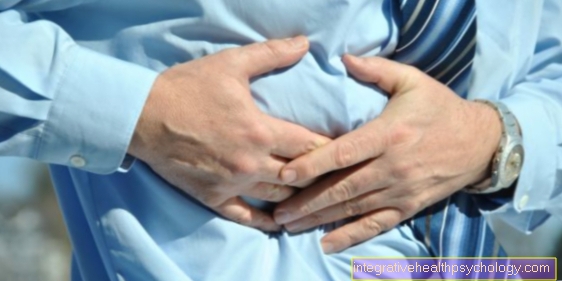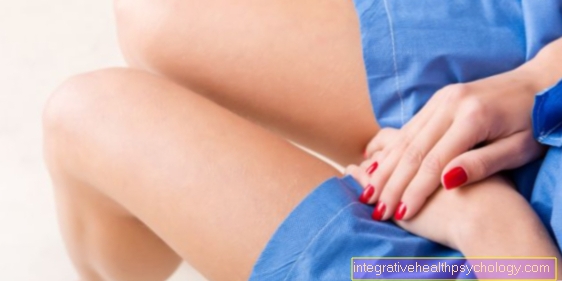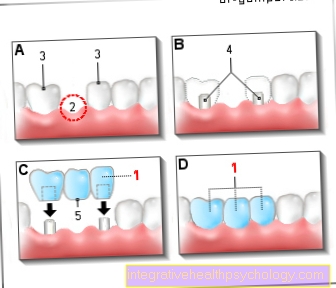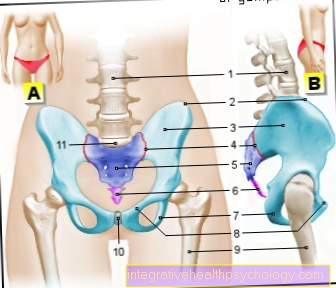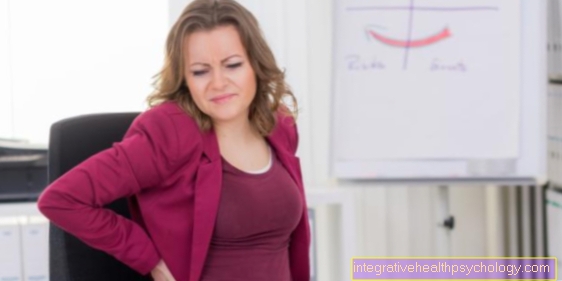Lumbar vertebrae
Synonyms
Lumbar spine, lumbar spine, lumbar spine
General
The lumbar vertebrae (lat. Vertebrae lumbales) form part of the spine. They start below the thoracic spine and end at the sacrum (Sacrum).
A total of five lumbar vertebrae form the area of the lumbar spine, which are numbered from top to bottom in LW 1 - LW 5.
Structure of the lumbar vertebra
In general, the structure of the lumbar vertebrae follows the construction principle of the entire spine, but here too there are differences to the other parts of the spine.
The Lumbar spine is characterized primarily by its size and bean shape. Of the Vertebral bodies (lat. Corpus vertebrae) is strong and stands over the feet (lat. Pediculi arcus vertebrae) with the Vertebral arch (lat. Arcus vertebrae) in connection.
Together they make that Vertebral hole (lat. Vertebrae foramen). The successive vertebral holes form a channel, the Vertebral canal. Here is the space for that Spinal cord with his Cases, annoy and Vessels.
The spinal cord only extends to the second at most Lumbar vertebrae, from then on go horsetail-like Nerve roots from that Cauda equina. The vertebral arches form a small incision on the vertebral canal, which creates a small hole to the left and right of the canal Intervertebral hole (lat. Intervertebral foramen). This represents the passage of the Spinal nerves represent.
The lateral and posterior extensions of the lumbar vertebra arise from the vertebral body (lat. Vertebrae process). They go to the back Spinous processes (Spinous process) from the lateral muscles of the Back muscles are embraced, but still remain palpable in the depth. They go to both sides Transverse processes (Transverse process), which are relatively long in the lumbar spine. In addition, each lumbar vertebra has an auxiliary process that arises from the vertebral arch downwards (Accessor process).
On both sides of the vertebral arch, the articular processes go up and down (Processus articularis superior / cranialis and inferior / caudalis). The upper articular process has a further thickening, which is called the teat process (Mamillary process) referred to as.
Figure lumbar vertebrae and lumbar spine
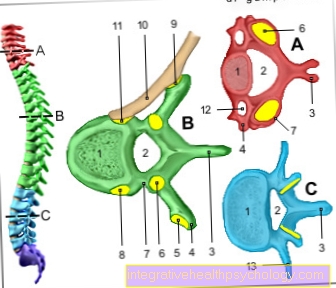
A - Fifth cervical vertebra (red)
B - sixth thoracic vertebra (green)
C - third lumbar vertebra (blue)
- Vertebral bodies - Corpus vertebrae
- Vortex hole - Vertebral foramen
- Spinous process
(mostly in cervical vertebrae
divided into two) -
Spinous process - Transverse process -
Transverse process - Articular surface for the rib -
Fovea costalis processus - Upper articular process -
Superior articular process - Vertebral arch - Arcus vertebrae
- Articular surface for the rib
on the vertebral body -
Fovea costalis superior - Rib-transverse process joint -
Articulatio costotransversaria - Rib - Costa
- Rib head joint -
Articulatio capitis costae - Transverse process hole
(only for cervical vertebrae) -
Foramen transversarium - Transverse process of the lumbar vertebra
("Costal process") -
Costiform process
You can find an overview of all Dr-Gumpert images at: medical illustrations
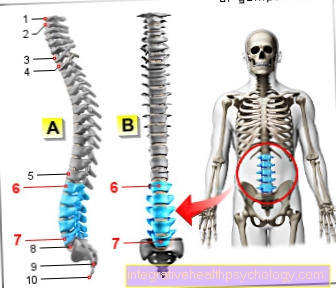
Lumbar spine (blue)
- First cervical vertebra (carrier) -
Atlas - Second cervical vertebra (turner) -
Axis - Seventh cervical vertebra -
Vertebra prominent - First thoracic vertebra -
Vertebra thoracica I - Twelfth thoracic vertebra -
Vertebra thoracica XII - First lumbar vertebra -
Vertebra lumbalis I - Fifth lumbar vertebra -
Vertebra lumbalis V - Lumbar cruciate ligament kink -
Promontory - Sacrum - Sacrum
- Tailbone - Os coccygis
You can find an overview of all Dr-Gumpert images at: medical illustrations
Injuries to the lumbar vertebra
The general low back pain denotes the Lumbar spine pain. These can be blunt, pressing or stabbing and, depending on the disease, sometimes radiate into the legs. The pain will go through Sedentary lifestyle, wrong sitting or wrong posture reinforced. Some lower back pain is short-lived because it is caused by unaccustomed stress, while others are caused by years of wear and tear and do not go away so easily.
So if pain is unusually severe or movement is severely restricted, a doctor should be consulted. Of the Lumbago occurs due to unusual heavy loads, e.g. when changing summer tires on the car. The pain is coming suddenly, unexpected and stabs in the cross. However, the pain never radiates into the leg.
At the Herniated disc of the lumbar spine severe pain radiating to the legs (on one or both sides) occurs. Parasitic sensations such as tingling or burning or numbness of the legs can also arise because the prolapsed Intervertebral disc the Nerve root can crush.
If any of the symptoms suit you, read below 'Symptoms of a herniated disc in the lumbar spine" further.
With a simple herniated disc, you can use a simple Operation of the herniated disc free the patient from their suffering. However, if the affected intervertebral disc is also unstable, an additional one must be performed operational stabilization respectively.
The Spondylarthrosis refers to wear and tear on the lumbar vertebrae, which slowly develops over time. The elasticity of the intervertebral discs is lost, whereby the Intervertebral spaces lose height and the neighboring lumbar vertebrae come closer. If the intervertebral space becomes so small that the Facet joints (this is the articulated connection between the upper and lower articular processes), this can lead to severe pain and pinch the nerves in the spinal canal. The quality of life of patients with chronic pain due to signs of wear and tear can be significantly improved with the help of special metal implants and modern surgery.
The Spondylolisthesis refers to the sliding of the vortex over the one below. This condition can be both congenital and acquired. In the interval pain occurs again and again and can finally only be done by one Stabilization operation to be improved.
A Spinal stenosis of the lumbar spine denotes a narrowing of the spinal canal. This occurs due to signs of wear and tear in the lumbar vertebrae. The facet joints rub against each other, causing them to expand. They then thicken and thus narrow the canal. Usually there is also a disc prolapse before, which also narrows the spinal canal. Ultimately, the only way to relieve the nerves is through surgical correction of the vertebra with additional stabilization. At the Vertebral fracture surgical stabilization is often achieved by injecting cement. Often they arise in older patients who take part osteoporosis Suffer.
The sacroiliac joint
synonym: SI joint, sacroiliac joint, sacrum-iliac joint, short sacro-iliac joint. The Sacroiliac joint provides the articulated connection between the Sacrum (lat. Sacrum) and the iliac bone (lat. Os ilium) represent.
construction: That's ISG is one Amphiarthrosis, that is, a joint in which there is almost no movement. The joint surfaces (lat. Ligamenta sacroiliaca interossea) are through Fiber cartilage firmly connected.Ligament security is ensured by the following ligaments: Ligamenta sacroiliaca anteriora, ligamenta sacroiliaca posteriora et interossea, ligamentum iliolumbale, ligamentum sacrotuberale and sacrospinale.
The movements in the sacral joint are called Nutation and Contranutation designated. This means that minimal movement in the lateral plane is possible. This movement is especially for the Birthing process of importance because in nutation together with the elongation of the Pubic symphysis the pelvic ring widens. This guarantees the passage of the newborn's head.
Diseases of Sacroiliac joint are diverse and range from the arthrosis, about the use of force, which can lead to fractures, to the ankylosing spondylitis, which is a congenital disease that often affects the sacrum-iliac joint. Acute or chronic inflammation of the SI joint is also possible and should be treated accordingly.






